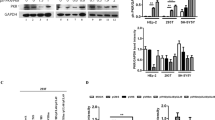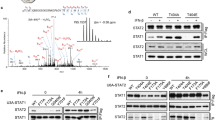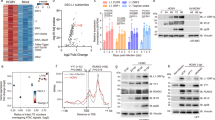Abstract
A virion protein of herpes simplex virus type 1 (HSV-1) specifically and potently activates transcription of the viral immediate early genes. Appropriate function of this protein, termed VP16, depends on an acidic transcriptional activation domain located within the 78 carboxyl-terminal amino acids of the protein. Mutated forms of the protein lacking this acidic domain lose the ability to activate transcription, and can dominantly interfere with the trans-activation function of native VP16 (ref. 1). We have prepared stably transformed mouse L cells that constitutively express a form of VP16 lacking its acidic activating domain. In this report we show that these cells are selectively impaired in their capacity to support the lytic infectious cycle of HSV-1, and that this impairment results from their inability to support immediate early transcription.
This is a preview of subscription content, access via your institution
Access options
Subscribe to this journal
Receive 51 print issues and online access
$199.00 per year
only $3.90 per issue
Buy this article
- Purchase on SpringerLink
- Instant access to full article PDF
Prices may be subject to local taxes which are calculated during checkout
Similar content being viewed by others
References
Trienzenberg, S. J., Kingsbury, R. C. & McKnight, S. L. Genes Dev. 2, 718–729 (1988).
Post, L. E., Mackem, S. & Roizman, B. Cell 24, 555–565 (1981).
Campbell, M. E. M., Palfreyman, J. W. & Preston, C. M. J. molec. Biol. 180, 1–19 (1984).
Mackem, S. & Roizman, B. J. Virol. 44, 939–949 (1982).
Preston, C. M., Cordingley, M. G. & Stow, N. D. J. Virol. 50, 708–716 (1984).
Lang, J. C., Spandidos, D. A. & Wilkie, N. M. EMBO J. 3, 389–395 (1984).
Triezenberg, S. J., LaMarco, K. L. & McKnight, S. L. Genes Dev. 2, 730–742 (1988).
McKnight, J. L. C., Kristie, T. M. & Roizman, B. Proc. natn. Acad. Sci. U.S.A. 84, 7061–7065 (1987).
Preston, C. M., Frame, M. C. & Campbell, M. E. M. Cell 52, 425–434 (1988).
Sadowski, I., Ma, J., Triezenberg, S. & Ptashne, M. Nature (in the press).
Campbell, M. E. M. & Preston, C. M. Virology 157, 307–316 (1987).
Dixon, R. A. F. & Scahffer, P. A. J. Virol. 36, 189–203 (1980).
Frankel, A. D., Bredt, D. S. & Pabo, C. O. Science 240, 70–73 (1988).
Laemmli, U. D. Nature 227, 680–685 (1970).
Towbin, H., Staehelin, T. & Gerdon, J. Proc. natn. Acad. Sci. U.S.A. 76, 4350–4354 (1979).
Cooper, P. D. in Methods in Virology Vol. 3 (Academic, New York and London, 1967).
Maniatis, T., Fritsch, E. F. & Sambrook, J in Molecular Cloning, A Laboratory Manual (Cold Spring Harbor Laboratory, Cold Spring Harbor, New York, 1982).
Perry, L. J., Rixon, F. J., Everett, R. D., Frame, M. C. & McGeoch, D. J. J. gen. Virol. 67, 2365–2380 (1986).
Author information
Authors and Affiliations
Rights and permissions
About this article
Cite this article
Friedman, A., Triezenberg, S. & McKnight, S. Expression of a truncated viral trans-activator selectively impedes lytic infection by its cognate virus. Nature 335, 452–454 (1988). https://doi.org/10.1038/335452a0
Received:
Accepted:
Issue Date:
DOI: https://doi.org/10.1038/335452a0
This article is cited by
-
Transcription factor decoy: a pre-transcriptional approach for gene downregulation purpose in cancer
Tumor Biology (2015)
-
Gene Therapy Strategies: Can We Eradicate HIV?
Current HIV/AIDS Reports (2011)
-
Can HIV be cured with stem cell therapy?
Nature Biotechnology (2010)
-
Viral complementation allows HIV-1 replication without integration
Retrovirology (2008)
-
Combinatorial Drug Discovery: Which Methods Will Produce the Greatest Value?
Nature Biotechnology (1995)



